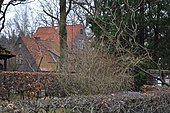Emil Maetzel
Emil Maetzel (born May 5, 1877 in Cuxhaven ; † June 23, 1955 in Hamburg ) was a German architect , painter , graphic artist and sculptor and co-founder of the Hamburg Secession .
Life
In 1896 Maetzel graduated from the Johanneum in Hamburg. From 1900 he studied architecture in Hanover , Dresden and Paris . During the First World War he was used in the railway replacement battalion in Berlin . From 1907 to 1933 he was the head of the urban planning department in the Hamburg building deputation. In this role he was in charge of the construction of the Hamburg Central Station . He worked closely with the then senior building director Fritz Schumacher and was a representative of the moderate variant of New Building in architecture . According to these architectural ideas, he also designed his villa , which was built in 1924 as a summer house and in 1926 as the main house in the outlying Hamburg district of Volksdorf , which is surrounded by 7,000 m² of land. In 1922 he became a member of the Hamburg Freemason Lodge Zur Hanseatentreue .
In 1910 Maetzel married Dorothea Maetzel-Johannsen (* 1886 in Lensahn ; † 1930 in Hamburg). She was also a painter and draftsman . From 1906 to 1909 she completed an apprenticeship at the Hamburg vocational school for girls and worked as a teacher in Schleswig for a year . The couple had four children: Ruth (July 21, 1911 - October 22, 2002), Bogumil (1913 - November 1989), Peter (1915 - July 1940) and Monika (1917 - October 10 2010).
In 1918 Maetzel and his wife settled in Hamburg. In 1920 he joined the Hamburg Art Association . In 1921 he set up his own studio. He was a co-founder of the Hamburg Secession , an artists' association founded in 1919, in which the styles of Expressionism , Expressive Realism and New Objectivity emerged . From 1928 to 1933 he was chairman of the artists' association. The annual exhibition of the Secession was the first to be closed in March 1933 by order of the National Socialists as the then new rulers. In 1933 Maetzel's forced retirement, initiated by the National Socialists, took place. In 1937 five of his woodcuts were removed from the Kunsthalle Hamburg as degenerate art . After the war he was appointed building director retrospectively in 1945. From 1948 he was second chairman of the re-established Hamburg Secession.
A tombstone for Emil Maetzel and his wife is on the grave site at the Hamburg cemetery Ohlsdorf , grid square S 12 (near Chapel 1). Her daughter Monika was also buried there.
plant
Artistically, Maetzel was essentially inspired by Brücke Expressionism . He painted a large number of pictures in this style that he favored. In addition, he collected African sculptures, the shape and color of which was also reflected in his primitivist pictures. He developed his own expressionist style. Since, in addition to his professional activity, he was also a regular organizer of exhibitions and Hamburg artist festivals and had already acquired a significant reputation as an artist , he was one of the central figures of Hamburg's cultural life in the 1920s.
Emil Maetzel's work can now be seen in part in the Kunsthalle Hamburg, the Hamburg Museum of Art and Commerce and the art collection of the Hamburger Sparkasse .
- selection
Honors
- The Maetzelweg in Hamburg - Volksdorf has had his name since 1960.
- The Emil-Maetzel-Weg in Cuxhaven was named after him in 2019.
literature
- Karin von Behr: Emil Maetzel. Builder. Painter. Secessionist. An artist's life in Hamburg in the 1920s . With a preface by Rüdiger Joppien . Neumünster, Hamburg 2013, ISBN 978-3-529-02853-3 .
- Maike Bruhns : Emil Maetzel: late work 1945–1955. Wachholtz, Kiel 2015, ISBN 978-3-529-03436-7 .
- Roland Jaeger, Cornelius Steckner: Zinnober - Hamburg art scene 1919–1933 . Hamburg 1983, ISBN 3-924225-00-1 , p.
Web links
- Maetzelhaus Foundation
- Maetzel artist house
- Biography on Galerie Herold
- Hamburg Notes of the Patriotic Society , April 2004; PDF document, 932 kB ( Memento from July 19, 2004 in the Internet Archive )
- Hamburger Kunsthalle, Art of the Twenties , April 2004
Individual evidence
- ^ Floor plan of the building ensemble with Gerhard Hirschfeld: Building in Volksdorf. 400 years of building history in a Hamburg district , Schaff-Verlag, Hamburg, 2018, ISBN 978-3-944405-41-4
- ^ Ohlsdorf and the artists of the secession at Förderkreis Ohlsdorfer Friedhof
- ↑ Christian Hanke: Hamburg's street names tell a story . 4th edition, Medien-Verlag Schubert, Hamburg 2006, ISBN 3-929229-41-2 , p. 341.
| personal data | |
|---|---|
| SURNAME | Maetzel, Emil |
| BRIEF DESCRIPTION | German architect, painter, graphic artist and sculptor |
| DATE OF BIRTH | May 5, 1877 |
| PLACE OF BIRTH | Cuxhaven |
| DATE OF DEATH | June 23, 1955 |
| Place of death | Hamburg |












